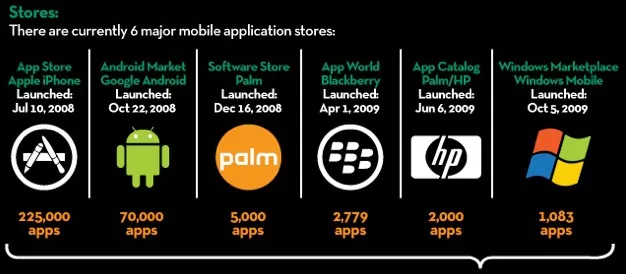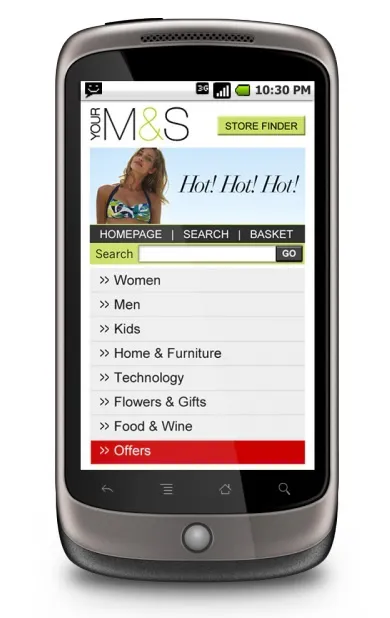App-solutely fabulous: a brief history of the app
July 2008: Steve Jobs announces that the iPhone App Store has gone live with 500 apps created by a plethora of third party developers.
Three years later: Apple announces that over 200 million iPhone, iPad and iPod Touch users have downloaded more than 15 billion apps from its App Store.
Within 36 months, Apple singlehandedly created and embedded a new mobile platform in the lives of countless consumers. There had been mobile applications before, but never had they achieved such a smooth and popular integration into mobile devices and the way people used them.
The App Store now boasts over 425,000 apps, of which 100,000 are native apps for the iPad, which at the time of writing has been available for less than two years. To businesses that have developed paid-for apps, and the legions of new app developers that have come onto the market, Apple has reportedly paid out over $2.5 billion in royalties. (They take a 30% cut on everything sold through the App Store, or through the apps themselves, leaving 70% for the creators.)
Building on the success of its iTunes store, Apple’s App Store was in many ways a natural progression. Consumers had become used to instantly downloading music and other digital media to their Apple devices. With apps, the kind of software that had once only been available for computer users via disc media or as a website download suddenly became centrally available, ranked and updateable for a growing range of multi-featured devices. And individuals and businesses alike could take advantage of this.
Today the App Store is a major force within the software industry. Many businesses that would have developed traditional software applications are increasingly turning their attention to the app market. Not least because Apple’s App Store has kickstarted (or resurrected) app ecosystems on other mobile and desktop platforms. Nokia’s much-publicised adoption of Windows Phone, BlackBerry’s development of App World, and of course the rise and rise of Google’s Android operating system, has created a diverse market for any business that wants to move into app development.
Apple’s App Store clearly has the lion’s share of the current app market Copyright © Ricky Linn / Online Schools
New platforms – different approaches
Whilst this app market growth is dramatic, careful thought does need to be given at the outset as to how your small business is best-served by mobile platforms.
The biggest one is whether your money could be better spent on first developing a website that is optimised for mobile devices – most notably smartphones. Bango (www.bango.com) in their mobile apps white paper suggest that it “is often better to spend some of your budget on getting a better web experience to replace the need for a mobile application.”
They go on to explain:
“All phones have a web browser and developing a website that looks great on leading mobile devices will give your business better market coverage and a simple way to promote to your entire audience via the same URL they are already familiar with. It is a quick, cost-effective solution that you own and control; it does not cost money to submit or require approvals. Plus the latest mobile browsers can deliver desktop-style capabilities, it’s far removed from the mobile WAP browsers of years past.”
Clearly as with all business decisions you must carefully assess your desire to move into app development. Resources in a growing business are often limited; ask yourself whether there is a real business case within your enterprise to prioritise the development of an app.
A genuine alternative to achieve first – building a website that is optimised for mobile devices – has become something of an industry in its own right. Some of the leading services you could use to build your business’s mobile web presence include:
- Net Biscuits (www.netbiscuits.com)
- Mobify (mobify.me)
- Onbile (www.onbile.com)
- MoFuse (www.mofuse.com)
- Wapple (wapple.net)
- MobiSiteGalore (www.mobisitegalore.com)
- MobileiQ (mobileiq.com)
We will look in more depth at the question of whether you can do without one or the other – an app or a mobile-optimised site – in the next chapter.
Remember that over 80% of the apps that are downloaded – not just from the Apple App Store – are free. So your app is more likely to be one that cannot rely on making money from downloads alone. The business case for these apps can be a simple extension of your company’s brand; but to be downloaded in the first place, they will also need to offer something appealing.
High street stores, including Argos, Debenhams, M&S and Tesco, have all reaped the rewards of offering a free and function-filled app to their customers.
You don’t need to reinvent the wheel, but you do need to do something that is tailored to your business – and to either showing off, or sharing, its services.
Anyone that simply browses one of the app stores will be struck by the sheer diversity of the apps on offer. Apple’s mantra that ‘there’s an app for that’ rings true, as every conceivable subject seems to have an app to support it. Anyone that is thinking about developing an app for their business should spend some time searching through the key app stores to familiarise themselves with what apps are already in the marketplace, and think about how theirs can be sufficiently similar and sufficiently unique to be a success.
This can be done online from any computer in the case of the Android Market (market.android.com), Windows Phone Marketplace (marketplace.windowsphone.com) and BlackBerry App World (appworld.blackberry.com/webstore).
A computer with iTunes installed can browse the App Store for iPhone, iPod and iPad by clicking on iTunes Store, and then the App Store tab along the top of the window.
The M&S mobile site has reportedly attracted over 1.2 million customers Copyright © Marks & Spencer
Even though the big brands can give away their apps for free as simply an additional retail channel, this doesn’t mean that paid-for apps can’t be successful. The pricing of a paid-for app is developing into a science in its own right. The $0.99 (£0.69) app has reined supreme on Apple’s App Store for some time, but this doesn’t mean that your business has to make the price point of its app low.
As with all pricing decisions, your business’s understanding of its market and the consumers that inhabit that space will lead you to the ideal price point for your app. Premium prices can be charged if the market is present and is willing to pay. For instance, the app that allows the control of video surveillance cameras from Lextech (lextech.com) costs an amazing $899.99! (Read more about how to correctly price your business’s app in chapter 8.)
Web apps making waves
The newest kid on the app block is the web app. It is important to understand how web apps differ from their smartphone cousins. Instead of being items you download from a central app store, they are accessed from your phone or tablet’s web browser at a url – e.g. the Kindle cloud reader app at read.amazon.com – from where they can be bookmarked, or ‘pinned’ to your device’s home screen like any other app.
A web app is clearly a popular choice for any business that wants to distribute its software directly to customers. However, it is important to understand that the web app has a very specific environment in which it must operate – namely an internet browser. On the one hand this is a strength: every consumer with a computer will have an internet browser. But not all browsers are compatible, nor will all 3G-equipped consumers be willing or able to use their data packages to access your app on the go. An ability to store information for offline browsing is therefore crucial in the development of any web app.
Web apps have been recently adopted by, amongst others, the Financial Times. In the first ten days of its release, over 100,000 readers used the FT web app on their iPad or iPhone to access the FT’s publications. Available by typing in apps.ft.com/ftwebapp to the Safari internet browser on iPhone and iPad, it looks and behaves just like the native app once available from Apple’s App Store. The difference is that with their web app, the FT don’t have to pay Apple 30% of any sales they make when someone buys content through it. They also get to access and retain subscriber information, crucial for future marketing efforts.
The idea is to ‘untether’ the FT from the App Store, and give the company more independence with the sale of its content. And going forward, the FT can ensure that customers can access content on any platform, no matter which devices they may switch to and from. Avoiding Apple’s App Store altogether will obviously dent the FT’s profile and discoverability in that environment, but the company is confident that its web app will prove successful.
“The FT Web app offers our customers flexibility and freedom of choice with access to our ...


